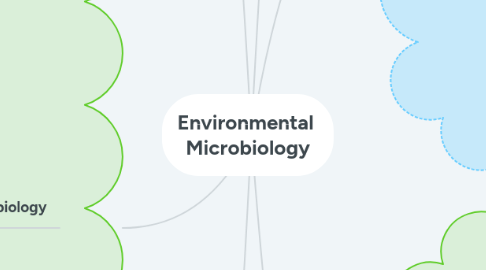
1. variety and habitats
1.1. variety of carbon and energy sources
1.2. different physical conditions
1.2.1. Extremophile s
1.2.1.1. – pH – Temperature – Salinity
1.2.2. Thermus aquaticus
1.2.2.1. produce Taq polymerase
1.3. Symbiosis
1.3.1. – Ruminants and bacteria in the rumen
1.3.1.1. Bacteria ferment cellulose protozoa keep bacteria under control
1.3.1.2. Truffles
1.3.2. Mycorrhizae
1.3.2.1. Ectomycorrhizae
1.3.2.2. Arbuscular mycorrhizae
2. Biogeochemical Cycles
2.1. sulfur
2.2. Nitrogen Cycle
2.2.1. organic compounds
2.2.2. Molecular nitrogen (N2) 80%
2.2.3. specific microorganisms
2.2.3.1. Microbial decomposition
2.2.3.1.1. Amino acids
2.2.3.2. Microbial ammonification
2.2.3.2.1. Ammonia
2.2.3.3. nitrification
2.2.3.3.1. Nitrite ion
2.2.3.4. Denitrification
2.2.3.4.1. N2
2.2.3.5. fixation
2.2.3.5.1. Ammonia
2.3. Carbon Cycle
2.3.1. carbon in organic compounds
2.3.1.1. cellulose
2.3.1.2. proteins
2.3.1.3. fats
2.3.1.4. starches
2.3.2. 0.03% of carbon dioxide
2.3.3. Chemoheterotrophs
2.3.3.1. animals
2.3.3.2. protozoa
3. Bioremediation
3.1. detoxify or degrade pollutants using microbes
3.1.1. affected by temperature
3.2. Plastics
3.2.1. polylactide (PLA)
3.2.1.1. lactic acid fermentation
3.2.1.2. degrades in a few weeks
3.2.2. PHA
3.2.2.1. degrade more easily
3.2.2.2. stand higher temperatures
3.2.2.3. fermented corn sugars
3.3. Solid Municipal Waste
3.3.1. anaerobic
3.3.2. methanogens
3.3.2.1. methane
3.3.2.1.1. electricity
3.3.2.1.2. natural gas
3.4. Composting
3.4.1. plant remains
3.4.1.1. humus
3.4.2. Bioaugmentation
3.4.2.1. specific microbes
3.4.3. thermophilic bacteria
3.4.3.1. 55-60°C in a couple of days
3.4.3.2. replaced by mesophilic populations
4. Aquatic Microbiology
4.1. the study of microorganisms and their activities in natural waters
4.1.1. Large numbers of microorganisms
4.1.1.1. sewage water
4.1.1.2. industrial organic wastes
4.2. Freshwater Microbiota
4.2.1. Littoral zone
4.2.1.1. along shore plants
4.2.2. Limnetic zone
4.2.2.1. algae and cyanobacteria
4.2.2.1.1. Profundal zone
4.2.3. Benthic zone
4.2.3.1. no light and little O2
4.2.3.2. bottom sediment
4.2.4. Light
4.2.4.1. photosynthetic algae
4.3. Seawater Microbiota
4.3.1. Phytoplankton 100 m
4.3.1.1. Oxygen
4.3.1.1.1. aerobic bacteria
4.3.1.2. Photosynthetic cyanobacteria
4.3.1.3. fix carbon
4.3.1.4. And fix nitrogen
4.3.2. Bioluminescent Bacteria
4.3.2.1. produce Luciferase enzyme
4.3.2.2. produce photon
4.4. Microbial Water Pollution
4.4.1. feces enter the water supply
4.4.2. 900,000 people become ill each year
4.4.3. 2 million deaths
4.4.4. typhoid
4.5. Chemical Water Pollution
4.5.1. Industrial and agricultural
4.5.1.1. resistant to biodegradation
4.5.1.2. Mercury(methyl mercury)
4.5.1.2.1. effects on the nervous system
4.6. Eutrophication
4.6.1. detergents
4.6.1.1. phosphates in lakes
4.6.1.1.1. algal blooms
4.6.2. oxygen in water is used up
4.6.2.1. killing the fish
5. Water Treatment
5.1. Filtration
5.1.1. Sand filtration
5.1.2. activated charcoal
5.1.2.1. dissolved organic chemical pollutants
5.2. free of disease-causing microbes
5.3. Coagulation
5.3.1. holding reservoir
5.3.1.1. particulate suspended settle out
5.3.2. flocculation
5.3.2.1. removal of colloidal materials
5.3.2.1.1. floc
5.4. Disinfection
5.4.1. water is chlorinated
5.4.2. Ozone
5.4.2.1. no taste or odor
5.4.2.2. little residual effect
5.5. Water Purity Tests
5.5.1. Indicator organisms
5.5.1.1. Coliforms
5.5.1.1.1. ferment lactose to acid plus gas
5.5.1.1.2. Fecal coliform is E. coli
5.5.1.1.3. The membrane filtration
6. Wastewater Treatment
6.1. used for washing and toilet wastes
6.2. Primary treatment
6.2.1. Removal of solids
6.2.1.1. sedimentation tanks
6.2.2. Biochemical Oxygen Demand (BOD)
6.2.2.1. biologically degradable organic matter in water
6.2.2.2. oxygen required by bacteria
6.3. Secondary treatment
6.3.1. dissolved organic matter
6.3.1.1. Aeration
6.3.1.1.1. encourage the growth of aerobic bacteria
6.3.1.1.2. oxidize the dissolved organic matter to carbon dioxide and water
6.3.2. Settling tank,
6.3.2.1. anaerobic sludge digester
6.3.3. Disinfection and Release
6.3.3.1. chlorination
6.3.4. Sludge Digestion
6.3.4.1. anaerobic sludge digesters
6.3.5. Sludge settles out in this stage
6.4. septic tank
6.4.1. The sludge in the tank must be pumped out periodically
6.4.2. effluent entering the soil is decomposed by soil microorganisms
6.5. Oxidation Ponds
6.5.1. lagoons or stabilization ponds
6.5.1.1. deep enough
6.5.1.1.1. almost entirely anaerobic
6.5.2. adjoining pond or system
6.5.2.1. Algae use carbon dioxide
6.5.2.1.1. encourages the activity of aerobic microbes
6.6. Tertiary treatment
6.6.1. remove all the BOD
6.6.2. nitrogen
6.6.3. phosphorus
6.6.4. Filters of fine sands and activated charcoal
6.6.5. Chemical precipitation
6.6.6. suitable for drinking
